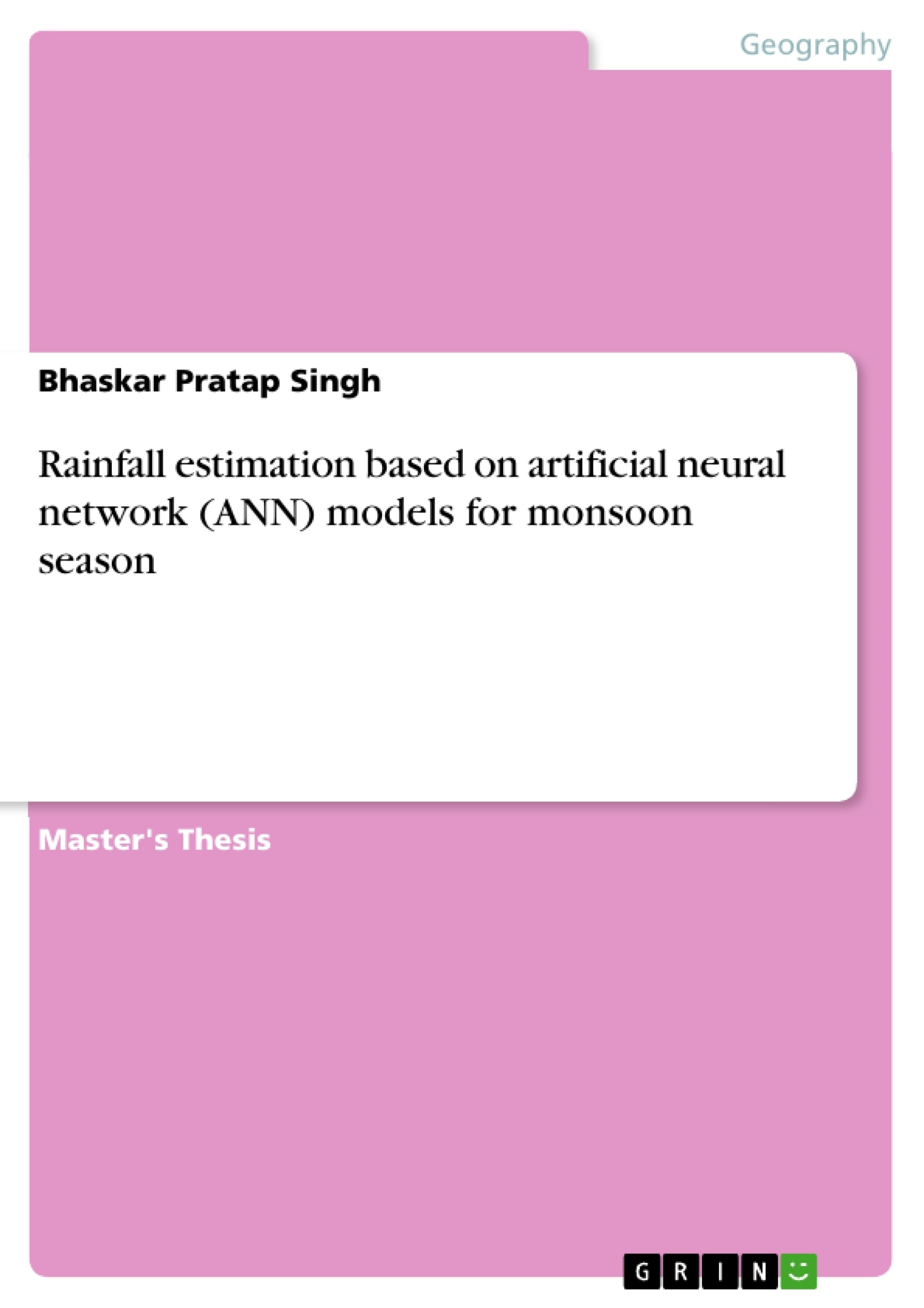In this master thesis the author will estimate the rainfall based on artificial neural network (ANN) models for monsoon season. The accurate rainfall prediction is one of the greatest challenges in hydrology. Forecast of any natural and usual event call for information regarding its phase of occurrence as well as nature. In the present study, artificial neural network (ANN) with different activation functions has been employed, to estimate daily monsoon rainfall of Pusa, Samastipur, in Bihar, India.
The daily mean temperature, relative humidity, vapour pressure and rainfall data of period (1st June to 30th September) for years 1981-1989, 1992-1994, 1996-2002 and 2004-2008 were used for training and data for years 2009-2013 were used to test the models. The sensitivity analysis was carried out to identify the most significant parameter for daily rainfall prediction. The Neuro solution 5.0 software was used for designing of ANN models based on sigmoid axon and hyperbolic tangent axon activation functions. All the ANN networks were trained and tested with feed forward back propagation algorithm. The performance of the models were evaluated qualitatively by visual observation and quantitatively using different statistical and hydrological indices viz. mean square error, correlation coefficient, akaike’s information criterion, coefficient of efficiency and pooled average relative error.
It was found that the performance of the ANN single hidden layer model based on sigmoid axon activation function is better than the ANN model based on hyperbolic tangent axon activation function. The best ANN models revealed that two days lag time was found to be satisfactory for set of inputs to the model. The sensitivity analysis indicated that the most significant input parameter besides rainfall itself is the vapour pressure in daily rainfall prediction for study area.
Inhaltsverzeichnis (Table of Contents)
- INTRODUCTION
- REVIEW OF LITERATURE
- Artificial Neural Networks (ANNs)
- Sensitivity Analysis
- MATERIALS AND METHODS
- Description of Study Area
- Physiographic description
- Soil characteristics
- Cropping pattern
- Climatology
- Data Acquisition
- Pre-analysis and formulation of input and output data
- Development of Models
- Artificial neural networks (ANNs)
- Description and application of ANNS
- The biological basis of ANNS
- General
- Basic concept of artificial neural network
- Network architecture
- Neurons and layers
- Output of the nodes
- Propagation law
- The Back-propagation algorithm
- Activation functions
- Sigmoid axon function
- Hyperbolic tangent axon function
- Selection of network architecture
- Artificial neural networks (ANNs)
- Development of ANN Models
- Pattern I
- Pattern II
- Pattern III
- Training and testing of ANN models
- Sensitivity Analysis
- Performance Evaluation Indicators
- Statistical indices
- Mean square error (MSE)
- Correlation coefficient (CC)
- Akaike's information Criterion (AIC)
- Hydrological indies
- Coefficient of efficiency (CE)
- Pooled average relative error (PARE)
- Statistical indices
- Description of Study Area
- RESULTS AND DISCUSSION
- Development of Rainfall Prediction Models
- Artificial neural network (ANN) models
- ANN models with nine input parameters and one output parameter (Pattern I)
- ANN models with six input parameters and one output parameter (Pattern II)
- ANN models with three input parameters and one output parameter (Pattern III)
- Artificial neural network (ANN) models
- Performance Assessment of Developed Models
- Qualitative evaluation
- Quantitative evaluation
- Statistical indices
- Hydrological indices
- Sensitivity Analysis
- Sensitivity analysis of the artificial neural network (ANN) model
- Development of Rainfall Prediction Models
- Development and evaluation of artificial neural network models for rainfall prediction during the monsoon season.
- Analysis of various input parameters and their influence on model performance.
- Assessment of model accuracy using statistical and hydrological indices.
- Investigation of the sensitivity of ANN models to different input parameters.
- Contribution to improved understanding of rainfall patterns and water resource management in the study area.
Zielsetzung und Themenschwerpunkte (Objectives and Key Themes)
The objective of this thesis is to develop and assess artificial neural network (ANN) models for predicting rainfall during the monsoon season in a specific study area. This research explores the potential of ANNs in improving rainfall estimation accuracy and contributing to better water resource management.
Zusammenfassung der Kapitel (Chapter Summaries)
The introductory chapter provides context and background information on the research, emphasizing the significance of accurate rainfall prediction for water resource management. This chapter also outlines the research objectives and methodology. Chapter 2 comprehensively reviews relevant literature on artificial neural networks and their applications in rainfall estimation, along with a discussion on sensitivity analysis methods. Chapter 3 delves into the materials and methods used in the study, detailing the study area description, data acquisition processes, development of ANN models, and performance evaluation indicators.
Schlüsselwörter (Keywords)
This research focuses on artificial neural networks, rainfall estimation, monsoon season, sensitivity analysis, performance evaluation, statistical indices, hydrological indices, and water resource management. It investigates the application of ANN models in predicting rainfall, exploring their accuracy and sensitivity to different input parameters.
- Quote paper
- Bhaskar Pratap Singh (Author), 2014, Rainfall estimation based on artificial neural network (ANN) models for monsoon season, Munich, GRIN Verlag, https://www.grin.com/document/469953



